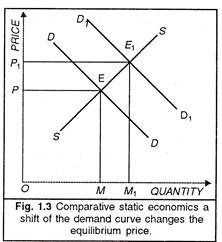The below mentioned article provides a study note on comparative static economics.
Static economics deals with explaining the determination of equilibrium values with a given data.
Any change in the determinants of equilibrium disturbs the equilibrium position.
In other words, when there is a change in the factors which establish equilibrium of demand and supply, a new equilibrium position comes into being. Comparative static economics studies the comparison of the old and new equilibrium positions. It does not study the path of change.
ADVERTISEMENTS:
In comparative static economics, we take only the first equilibrium position and the final one; we can compare them to find out the change. Instead of examining step by step the whole process of transition from one stage of equilibrium to another, we take only two “Still” pictures and compare them.
This method of analysis is called comparative statics. For example, when the demand as well as the supply of onions is 50 kgs., price is one Re. per kg. Now suppose the demand increases to 6 kg’s. while supply remains the same. Price of onions increases to Rs. two per kg.
The study of the two equilibrium prices of onions is called comparative economic statics. According to Prof. Lipsey, “Comparative statics involves a comparison of a new equilibrium position with original equilibrium position due to change in some economic variable.”
According to Baumol, “Comparative static analysis can be used to show economic equilibrium before and after a change in one or more variables without regard to the time required.”
ADVERTISEMENTS:
We can explain the meaning of comparative static economics through Figure 1.3.
The diagram shows the determination of equilibrium price through the interaction of the forces of demand and supply. E is the point where demand for and supply of the good are equal and OP price is determined. Now due to some reason or the other, demand for the commodity increases.
That is why the DD demand curve shifts to D1D1. The new demand curve D1D1 intersects the supply curve SS on point E1. Here the equilibrium price is determined at the level OP1 In comparative static economics the old and the new equilibrium positions are compared.
ADVERTISEMENTS:
In the above figure, we can compare E and E1 points of equilibrium. But it does not show how the new point of equilibrium i.e. has been reached. In other words, comparative static economics does not show the path of change. Here we can only compare the two still pictures of the competitive market.
